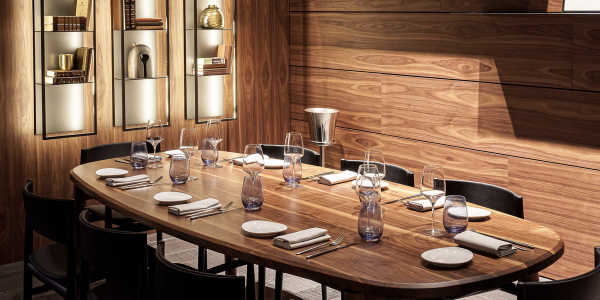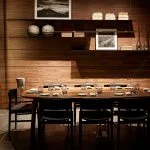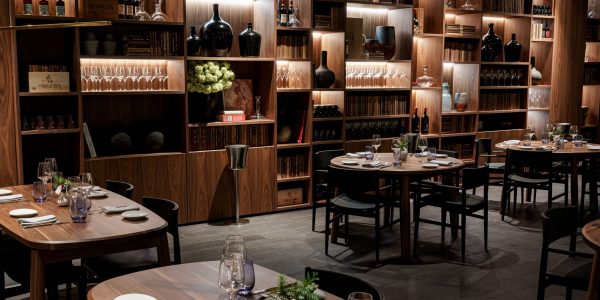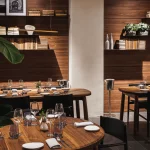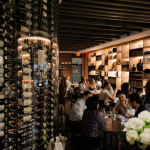By Jenifer Vogt

The flavor was as profound and complex as any beef he’d ever tasted. Steak in the States was bland, in need of sauce, but this simply prepared choice cut was perfectly grilled – seared on the outside, rare and warm internally – helped by hints of lemon and rosemary and coarse salt while letting the flavor of the meat itself dominate. Amazing. Transcendental.
― Andrew Cotto, Cucina Tipica: An Italian Adventure
When a food writer like Andrew Cotto describes a steak as “transcendental,” in this case, Florentine Steak, called La Fiorentina on Toscana Divino’s menu, you know you’re in for something special. The aura around this steak is reminiscent of those Dos Equis commercials years ago that featured, “the most interesting man in the world.” He epitomized everything a man should be, just like La Fiorentina epitomizes everything a steak should be and it’s not far-fetched to call it, “the most interesting steak in the world.” The Florentine Steak has an air of refinement and a sophisticated global fan base of gourmands, just like the Dos Equis man.
If you’re curious to try this gourmet steak, take note that it’s called by a few different names, but just like the proverbial rose, La Fiorentina tastes just as delicious whether it’s called Bistecca alla Fiorentina or Bistecca Fiorentina, as it’s known in Italy, or Florentine Steak or Florentine Beef Steak when it’s translated to English. All refer to the steak so emblematic of La Città di Firenze that the Florentines would like it to be included on the UNESCO World Heritage list just like the pizza from Naples is.
Florence, an Intellectual City of Artistic Achievement
To understand the folklore that surrounds Steak Florentine, you also need to know a little about the historical significance of the City of Florence because the two are inextricably connected. First, it’s one of the most beautiful places in the world. Upon seeing it for the first time, the Italian word mozzafiato comes to mind because it’ll take your breath away. Though Florentines are still waiting on the decision about Bistecca alla Fiorentina, in 1982, UNESCO declared most of the center of the city a World Heritage site.
Enchanted by its unique allure, the novelist E.M. Forster made Florence the backdrop for the budding romance between his two main characters, Lucy and George, in A Room with a View. Referencing the city’s magical ability to evoke romantic feelings, the lovesick George recounts that it, “worked some marvel” in Lucy. “It gave her light,” he affectionately exclaims.
Florence was the location of the most significant period of artistic and cultural achievement in the Western world — the Renaissance — which began around 1300 and heralded the end of the Dark Ages. The way the people thought began to change as they rejected the status quo that life was meant to be hard and arduous and began embracing a new worldview known as Humanism. The Humanist movement reinvigorated interest in studying the accomplishments and lifestyles of the ancient Greek and Romans. When the Florentines’ minds were opened to the Classics, they realized that earlier civilizations had lived with more sensuality, enjoyment and a profound appreciation of beauty.

A writer, love poet, and philosopher named Francesco Petrarca (1304-1374), considered the father of Humanism, and perhaps the first true scholar, ignited a cultural revolution that awakened the ingenuity of the masses. Petrarca told people that God gave them the untapped intellectual ability and creativity they needed to realize their full potential. He explained that reason and intellect did not contradict faith. In fact, taken together, they would lead to innovations in the arts and literature that had not been witnessed since the early Greeks and Romans.
The Oxford Art Database said about the importance of Petrarca’s influence that, “His work largely initiated the transition from the fragmentary humanism of the late Middle Ages to the more systematic classicism of the Renaissance.”
They further remarked that Petrarca’s teachings, “…are crucially important for the understanding of the development of a critical vocabulary for art, and for revealing how an appreciation of the visual arts began to be absorbed into the concerns of literary humanism.”
The Curious Connection Between Saint Lawrence, the Medici Family and Florentine Steak
At this point, one might wonder: but what does all of this information about the Renaissance have to do with steak and why did it become such a big deal in Florence? The answer begins with the story of Saint Lawrence, or San Lorenzo as he’s known in Italy. Saint Lawrence was a deacon of the Roman Church persecuted by Emperor Valerian in the mid-third century and brutally executed by grilling in 258, dying a martyr. Legend has it he was remarkably brave in the face of death, telling his executioners, “I am cooked on that side; turn me over.” Though there are no gruesome grilling analogies, he was eventually deemed the patron saint of cooks and chefs.
By the time of the Renaissance the powerful Medici family, known for their influential patronage of the arts, had risen to power in the City of Florence, and coincidentally, they were members of the church of Saint Lawrence, today the famous Basilica di San Lorenzo, which had originally been built in 393.
In 1419, desiring a modern church more suitable for his prestigious family, Giovanni di Bicci de’ Medici, a wealthy banker and the family patriarch, commissioned Filippo Brunelleschi, the leading architect of the time, to rebuild the church, which is part of a larger monastic complex. That’s what cemented the bond between the Medici family and Saint Lawrence, who also happens to be the co-patron saint of Florence (along with Saint John). The Medici family also funded many of the cherished artistic treasures found there, including Sandro Botticelli’s Birth of Venus.
The famous festival to celebrate Saint Lawrence, Festa di San Lorenzo, which takes place annually on August 10th, the day of his death, was initially organized by the Medici family and is still a major event. During their time, the Medici would have quarters of beef grilled and given freely to citizens. The story that’s been passed down among generations is that a group of English travelers visiting the city asked for some of the “beef steak,” which translates as, “bistecca” and that’s how Bistecca all Fiorentina was born.
Butchers Have an Important Role in Italy’s Culinary Culture
People who know Italy know there are twenty regions, each with a unique cuisine and food traditions that are based on that region’s distinct geography and history. It’s not possible to be a serious connoisseur of the cuisine of the Tuscany region, where the City of Florence is located, without knowing La Fiorentina. It reigns supreme beyond the city as the uncontested crowned queen of the gastronomy of Tuscany.

Steak Florentine is, undoubtedly, the most famous secondi piatti (the second or main course) in Tuscany. When diners take their first bite of this thick, choice cut of beef grilled over charcoal, simply seasoned and served rare, many exclaim that it’s, “come un sogno.” They’ll admit this is no ordinary steak. It’s more like a slice of heaven on earth.
Every Tuscan home chef knows how to make Florentine Steak and, though some may modify them, the traditional five ingredients are steak, fresh rosemary, fresh sage, extra virgin olive oil, coarse salt, and ground pepper. It seems simple, right? Well, it’s as simple as making an omelet or scrambled eggs. Meaning that, like with the simplicity of eggs, not everyone can make it equally well.
The quality of the beef is tantamount to whether a Steak Florentine is great or mediocre. Florentines don’t scrimp. They are discerning and will pay more for the finest cuts. Artisanal butchers are held in high esteem and the profession is considered a culinary art.
Nowadays, Americans buy their meat at the supermarket. Butcher shops in the U.S. are few and far between, but that wasn’t always the case. Baby boomers remember. They used to tag along to the butcher shop with their parents who were looking for the perfect cut of meat, either for an everyday dinner, or a special occasion, like the beef selected to serve on Christmas Day. The butcher knew everyone’s name and saved the best cuts of meat for his favorite customers. Everyone knew exactly where the meat came from, so nobody questioned the quality.
Butcher shops like that still exist in Italy and they’re a national treasure. In fact, the man often called, “the world’s most famous butcher,” Dario Cecchini has his shop, Antica Macelleria Cecchini, in Tuscany. He’s an eighth-generation butcher with deep respect for animals. Reverence is common in Italy’s food culture. Food is a lifestyle, not a single meal and Tuscans don’t like to waste food because their cucina povera mindset is the result of an unforgettable and frightening period of post-war famine. So, Cecchini doesn’t want your business if you’re just coming to his shop for Bistecca alla Fiorentina. He prefers “responsible carnivores,” who share his, “…ethics of respect for the animal by using every part well, from nose to tail.”
Though in America high-quality Angus beef is used for La Fiorentina, in Italy they farm a special breed of large cattle, called Chianina. It’s interesting to note that the heaviest recorded bull in the word, named Donetto, was a member of this Italian breed. He was born in 1949 in Tuscany’s Siena province. He stood a little over six feet tall and weighed more than 3,800 pounds. He was exhibited in Arezzo in 1955.

Florentines measure beef with their fingers and a good cut is 3-4 fingers and the beef must be aged about 30 days. A Florentine Steak is cooked rare because to cook such a thick steak to a higher internal temperature would result in a tougher outer crust. So, if you ask for steak cooked medium or well, your polite Italian server will acquiesce, but may frown a bit and — with the best of intentions — attempt to persuade you to try it the traditional way first.
One of Italy’s most popular food publications, La Cucina Italiana advises, “It’s cooked very little over live embers, 3 minutes per side and then 5 minutes standing on the bone. It should have a nice crust on the outside, but inside it is red, soft, and juicy.”
La Fiorentina at Toscana Divino
Toscana Divino’s executive chef, Andrea Marchesin has the same approach as Cecchini in terms of food waste and respect for animals. He and his team make every effort to use every part of an animal. Chef Andrea’s La Fiorentina, which weighs over two pounds and serves two people, is recognized among the best restaurants in Miami.
Once you’ve decided to try La Fiorentina, you have an important second choice to make: what wine will you pair with it? For Italians, food and wine go together as naturally as salt and pepper. Accompanying your Florentine Steak with a full-bodied Brunello or Chianti will elevate the dining experience. There are websites that provide solid advice on which Italian wines pair well with steak, but the sommelier and servers at Toscana Divino are trained in the nuances of the fine Italian wines in their extensive wine selection. Come visit one of the best restaurants in Miami and our staff will take the time to guide you toward selections that pair well with your meal and suit your preferences.
Another way to enjoy La Fiorentina at Toscana Divino in an even more memorable way is to select Chef Andrea’s Florentine Dinner for two. This is his innovative take on the classic multi-course Italian meal, just as it would be served in Italy, but he’s infused it with Florentine culinary history by including favorite regional dishes, such as Risotto Funghi e Tartufo, as well as others that aren’t seen that often on menus outside of Tuscany, such as Pici Senesi.
La Fiorentina is one example of an outstanding regional dish with a legacy, but outside of Tuscany, there are 19 other regions with equally interesting specialties and stories. Regardless of how well one knows Italian cuisine, nobody can know it all in one lifetime. People love Italian food, not just for the food itself, but also for the never-ending stories about the land, the people, the farming methods, the way food is prepared, the family traditions, and the ties to history. They love how Italians come together to enjoy the simple pleasure of a delicious meal and to live La Dolce Vita. Buon Appetito!







